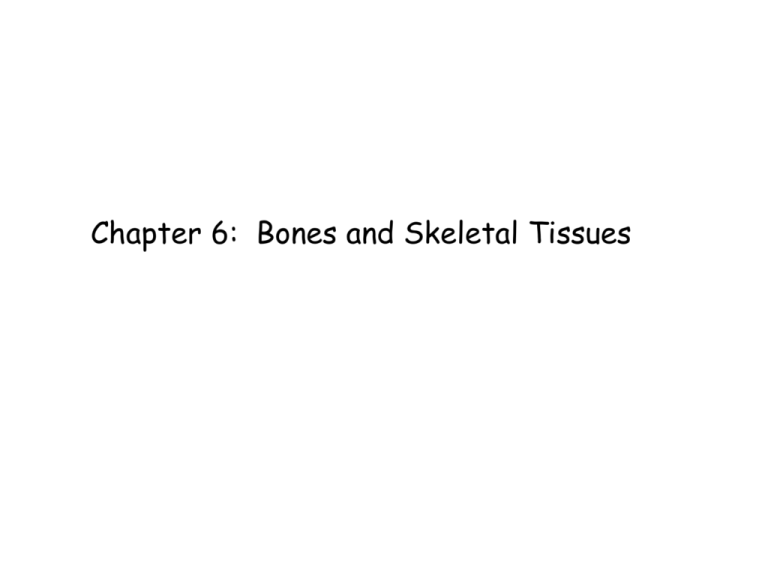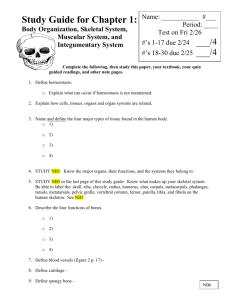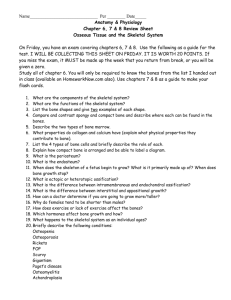Spongy bone Compact bone
advertisement

Chapter 6: Bones and Skeletal Tissues Cartilage in external ear Cartilage in Intervertebral disc Pubic symphysis Meniscus (padlike cartilage in knee joint) Articular cartilage of a joint Epiglottis Cartilages in Thyroid cartilage nose Articular Cricoid Cartilage cartilage of a joint Larynx Trachea Lung Costal cartilage Respiratory tube cartilages in neck and thorax Bones of skeleton Axial skeleton Appendicular skeleton Cartilages Hyaline cartilages Elastic cartilages Fibrocartilages Skeletal Cartilages • • • 1. Contain no blood vessels or nerves Dense connective tissue girdle of perichondrium contains blood vessels for nutrient delivery to cartilage 3 types: Hyaline cartilages – Provide support, flexibility, and resilience – Most abundant type 2. Elastic cartilages – Similar to hyaline cartilages, but contain elastic fibers 3. Fibrocartilages – Collagen fibers—have great tensile strength Growth of Cartilage • Appositional – Cells secrete matrix against the external face of existing cartilage • Interstitial – Chondrocytes divide and secrete new matrix, expanding cartilage from within • Calcification of cartilage occurs during – Normal bone growth – Old age Bones of the Skeleton Two main groups, by location • Axial skeleton: long axis of body: skull, vertebral column, rib cage • Appendicular skeleton: upper and lower limbs that attach to axial skeleton Long bones: longer than wide Irregular bones: complicated shapes Types of bones Flat bones: thin, flat, slightly curved Short bones •Cube shaped bones (in wrist and ankle) •Sesamoid bones (within tendons, e.g., patella) Functions of Bones • • • • • Support for the body and soft organs Protection for brain, spinal cord, and vital organs Movement: Levers for muscle action Storage of minerals (calcium and phosphorus) Storage of growth factors (like insulin-like growth factor) in bone matrix • Blood cell formation (hematopoiesis) in marrow cavities • Triglyceride (energy) storage in bone cavities Bone Markings Bulges, depressions, and holes serve as – Sites of attachment for muscles, ligaments, and tendons – Joint surfaces – Conduits for blood vessels and nerves Bone Markings: Projections • Sites of muscle and ligament attachment – Tuberosity—rounded projection – Crest—narrow, prominent ridge – Trochanter—large, blunt, irregular surface – Line—narrow ridge of bone – Tubercle—small rounded projection – Epicondyle—raised area above a condyle – Spine—sharp, slender projection – Process—any bony prominence Bone Markings Projections that help to form joints – Head: bony expansion carried on a narrow neck – Facet: Smooth, nearly flat articular surface – Condyle: Rounded articular projection – Ramus: Armlike bar Bone Markings: Depressions and Openings • Meatus: Canal-like passageway • Sinus: Cavity within a bone • Fossa: Shallow, basinlike depression • Notch: indentation at the edge of a structure • Groove: Furrow • Fissure: Narrow, slitlike opening • Foramen: Round or oval opening through a bone Bone Textures Compact bone Spongy bone • Compact bone – Dense outer layer • Spongy (cancellous) bone – Honeycomb of trabeculae Structure of a Long Bone • Diaphysis (shaft) – Compact bone collar surrounds medullary (marrow) cavity – Medullary cavity in adults contains fat (yellow marrow) • Epiphyses – Expanded ends – Spongy bone interior – Epiphyseal line (remnant of growth plate) – Articular (hyaline) cartilage on joint surfaces Articular cartilage Proximal epiphysis Diaphysis Distal epiphysis Spongy bone Epiphyseal line Compact bone Medullary cavity Compact bone Membranes of Bone • Periosteum – Outer fibrous layer – Inner osteogenic layer • Osteoblasts (bone-forming cells) • Osteoclasts (bone-destroying cells) • Osteogenic cells (stem cells) – Nerve fibers, nutrient blood vessels, and lymphatic vessels enter the bone via nutrient foramina – Secured to underlying bone by Sharpey’s fibers • Endosteum – Delicate membrane on internal surfaces of bone – Also contains osteoblasts and osteoclasts Endosteum Yellow bone marrow Compact bone Periosteum Perforating (Sharpey’s) fibers Nutrient arteries Structure of short, irregular and flat bones Spongy bone called diploë in flat bones •Periosteumcovered compact bone on the outside •Endosteumcovers the trabeculae Trabeculae Bone marrow between trabeculae Location of Hematopoietic Tissue (Red Marrow) • Red marrow cavities of adults – Trabecular cavities of the heads of the femur and humerus – Trabecular cavities of the diploë of flat bones • Red marrow of newborn infants – Medullary cavities and all spaces in spongy bone Microscopic Anatomy of Bone Osteogenic cell Stem cells in periosteum and endosteum that give rise to osteoblasts Osteoblast Matrix-synthesizing cell responsible for bone growth Microscopic Anatomy of Bone Osteocyte Mature bone cell that maintains the bone matrix Osteoclast Bone-resorbing cell Compact Bone: Haversian system, or osteon—structural unit Structures in the central canal Artery with capillaries Vein Nerve fiber •Central (Haversian) canal •Contains blood vessels and nerves •Lamellae Lamellae Collagen fibers run in different directions •Weight-bearing •Column-like matrix tubes Twisting force Compact bone Central (Haversian) canal Osteon Circumferential lamellae Osteocyte in a lacuna Perforating (Volkmann’s) canal: Perpendicular to central canal. Connects blood vessels and nerves of the periosteum with central canal Endosteum lining bony canals and covering trabeculae Lamellae Nerve Vein Artery Canaliculi Spongy bone Lamellae Central canal Lacunae Perforating (Sharpey’s) fibers Periosteal blood vessel Periosteum Lacuna (with osteocyte) Interstitial lamellae Microscopic Anatomy of Bone: Spongy Bone • Trabeculae – Align along lines of stress to resist stress – No osteons – Contain irregularly arranged lamellae, osteocytes, and canaliculi – Capillaries in endosteum supply nutrients Composition of Bone Organic • Osteogenic cells, osteoblasts, osteocytes, osteoclasts • Osteoid—organic bone matrix secreted by osteoblasts – Ground substance (proteoglycans, glycoproteins) – Collagen fibers • Provide tensile strength and flexibility Inorganic • Hydroxyapatites (mineral salts) – 65% of bone by mass – Mainly calcium phosphate crystals – Responsible for hardness and resistance to compression Bone Development • Osteogenesis (ossification)—bone tissue formation • Stages – Bone formation—begins in the 2nd month of development – Postnatal bone growth—until early adulthood – Bone remodeling and repair—lifelong Two Types of Ossification 1. Intramembranous ossification – – Membrane bone develops from fibrous membrane Forms flat bones, e.g. clavicles and cranial bones 2. Endochondral ossification – – Cartilage (endochondral) bone forms by replacing hyaline cartilage Forms most of the rest of the skeleton Intramembranous ossification 1 Collagen fiber Mesenchymal cell Ossification center Osteoid (bone Matrix) Ossification centers appear in the fibrous connective tissue membrane. • Selected centrally located mesenchymal cells cluster and differentiate into osteoblasts, forming an ossification center. Osteoblast 2 Bone matrix (osteoid) is secreted within the fibrous membrane and Osceocytes calcifies. • Osteoblasts begin to Osteoid secrete osteoid, which is Newly calcified calcified bone matrix within a few days. • Trapped osteoblasts become osteocytes. Osteoblast 3 4 Woven bone and periosteum form. Mesenchyme • Osteoid laid down between blood vessels in a random condensing to form the manner. The result is a periosteum network of trabeculae called woven bone. Vascularized mesenchyme Trabeculae of •condenses and becomes the woven bone periosteum. Blood vessel Lamellar bone replaces woven bone, just deep to the periosteum. Red marrow appears. • Trabeculae just deep to the periosteum thicken, and are Fibrous later replaced with mature periosteum lamellar bone, forming compact bone plates. Osteoblast • Spongy bone (diploë), consisting of distinct trabeculae, persists internally Plate of and its vascular tissue becomes compact bone red marrow. Diploë (spongy bone) cavities contain red marrow Endochondral ossification Childhood to •Uses hyaline cartilage blueprint adolescence •Hyaline cartilage breaks down Birth Articular Before ossification Secondary cartilage Week 9 Hyaline cartilage Area of deteriorating cartilage matrix ossification Month 3 center Epiphyseal blood vessel Spongy bone formation Spongy bone Medullary cavity Epiphyseal plate cartilage Bone collar 1 Blood vessel of periosteal Primary ossification bud center 3 Bone collar forms around hyaline cartilage model. 4 2 Cartilage in Periosteal bud Diaphysis gets longer, medullary the center of invades the cavity forms, the diaphysis internal cavities and ossification calcifies and spongy bone continues. 2o then develops begins to form. ossification cavities. center develops. 5 Epiphyses ossify. After, hyaline cartilage is only in the epiphyseal plates and articular cartilages. Postnatal Bone Growth How bones widen (appositional growth): • Osteoblasts beneath periosteum secret bone matrix • Osteoclasts on bone surface remove bone How bones widen • Cartilage divide and hypertrophy and are eventually replaced by bone (see next slide) Hormonal regulation of bone growth • Growth hormone stimulates epiphyseal plate activity • Thyroid hormone modulates activity of growth hormone • Testosterone and estrogens (at puberty) – Promote adolescent growth spurts – End growth by inducing epiphyseal plate closure GH stimulates the lengthening of bones at the epiphyseal plate. GH stimulates osteoblast activity & the proliferation of epiphyseal cartilage. New bone tissue replaces cartilage in this region. GH stimulates bone thickness by activating osteoblasts under the periosteum. Articular cartilage Bone of epiphysis Epiphyseal plate Bone of diaphysis Marrow cavity Cartilage Calcified cartilage Bone Bone of epiphysis Diaphysis Epiphyseal plate Resting chondrocytes Cartilage Calcified cartilage Bone Chondrocytes undergoing cell division chondrocytes enlarging Causes thickening of epiphyseal plate Calcification of extracellular matrix (chondrocytes die) Dead chondrocytes cleared away by osteoclasts Osteoblasts swarming up from diaphysis and depositing bone over persisting remnants of disintegrating cartilage Bone remodeling:continuous deposition and resorption of bone Why? 1. To make bones stronger 2. To maintain Ca 2+ homeostasis • Calcium is necessary for: transmission of nerve impusles, muscle contraction, blood coagulation, secretion by glands, cell division • Primarily controlled by parathyroid hormone (PTH) Blood Ca2+ levels Parathyroid glands release PTH PTH stimulates osteoclasts to degrade bone matrix and 2+ release Ca Blood Ca2+ levels • Calcitonin is secreted by C cells in the thyroid gland to prevent plasma Calcium from being too high Response to Mechanical Stress Load here (body weight) • Wolff’s law: A bone grows or remodels in response to forces or demands placed upon it • Observations supporting Wolff’s law: Head of – Handedness (right or left femur handed) results in bone of one upper limb being thicker and stronger – Curved bones are thickest where they are most likely Compression to buckle Tension here – Trabeculae form along lineshere of stress – Large, bony projections Point of occur where heavy, active no stress muscles attach • Bone fractures may be classified by four “either/or” classifications: 1. Position of bone ends after fracture: • Nondisplaced—ends retain normal position • Displaced—ends out of normal alignment 2. Completeness of the break • Complete—broken all the way through • Incomplete—not broken all the way through 3. Orientation of the break to the long axis of the bone: • Linear—parallel to long axis of the bone • Transverse—perpendicular to long axis of the bone 4. Whether or not the bone ends penetrate the skin: • Compound (open)—bone ends penetrate the skin • Simple (closed)—bone ends do not penetrate the skin All fractures can be classified based on these criteria: –Location –External appearance –Nature of the break Some common types of fractures Comminuted: Bone broken into 3 or more pieces. Common in people with brittle bones, such as elderly Compression: Bone is crushed. Common in porous bones (i.e. osteoporotic bone) subjected to fall or other trauma More types of fractures Spiral: Ragged break from twisting force on a bone, common in sports injury Epiphyseal: Epiphysis separates from the diaphysis along the epiphyseal plate. Tends to occur where cartilage cells are dying and calcification of the matrix is occurring Depressed: Broken bone is pressed inward. Typical in a skull fracture. Greenstick: Bone breaks incompletely, like a broken twig. Only one side of the shaft breaks. Common in kids Stages in the Healing of a Bone Fracture Internal callus Hematoma (fibrous tissue and cartilage) 1 A hematoma forms. Bony callus of spongy bone 3 Bony callus forms. 2 Fibrocartilaginous callus forms. External callus New blood vessels Spongy bone trabecula Healed fracture 4 Bone remodeling occurs. Homeostatic Imbalances • Osteomalacia and rickets – Calcium salts not deposited – Rickets (childhood disease) causes bowed legs and other bone deformities – Cause: vitamin D deficiency or insufficient dietary calcium • Paget’s disease – Excessive and haphazard bone formation and breakdown, usually in spine, pelvis, femur, or skull – Pagetic bone has very high ratio of spongy to compact bone and reduced mineralization – Unknown cause (possibly viral) – Treatment includes calcitonin and biphosphonates Osteoporosis •Loss of bone mass—bone resorption outpaces deposit •Spongy bone of spine and neck of femur become most susceptible to fracture •Risk factors: Lack of estrogen, calcium or vitamin D; petite body form; immobility; low levels of TSH; diabetes mellitus Treatment and prevention: •Calcium, vitamin D, and fluoride supplements • Weight-bearing exercise throughout life •Hormone (estrogen) replacement therapy slows bone loss •Some drugs (Fosamax, SERMs, statins) increase bone mineral density Developmental Aspects of Bones • Embryonic skeleton ossifies predictably so fetal age easily determined from X rays or sonograms • At birth, most long bones are well ossified (except epiphyses) • Nearly all bones completely ossified by age 25 • Bone mass decreases with age beginning in 4th decade • Rate of loss determined by genetics and environmental factors • In old age, bone resorption predominates







